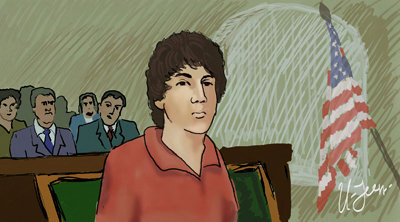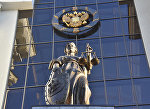BOSTON, December 4 (RAPSI, Ingrid Burke) - Certain of the restrictive measures previously imposed against Boston Marathon bombing suspect Dzhokhar Tsarnaev have been lifted, US prosecutors revealed in a notice filed with the federal court adjudicating the case Tuesday.
US Attorney General Eric Holder issued a memo August 27 imposing against Tsarnaev a variety of restrictions referred to as Special Administrative Measures (SAMs).
Tsarnaev’s defense team filed a motion to vacate the SAMs in October, challenging the “extraordinary and severe restrictions,” on various bases. The motion asserted that the SAMs were detrimental to the defense team’s capacity to adequately represent their client, noting: “Among other things, the SAMs limit Mr. Tsarnaev’s interactions with individuals assisting defense counsel and restrict the communications and other activities of the defense team in furtherance of the defense.”
Tuesday’s prosecution notice, signed off by US Attorney for the District of Massachusetts Carmen Ortiz, outlined three modifications that have been made to the SAMs following a November 12 motion hearing.
A copy of the initial SAMs memo that was attached as an exhibit to the October defense motion stated: “The inmate’s attorney may disseminate the contents of the inmate’s communication to third parties for the sole purpose of preparing the inmate’s defense – and not for any other reason – on the understanding that any such dissemination shall be made solely by the inmate’s attorney, and not by the attorney’s staff.”
Tuesday’s prosecution notice explains that pursuant to the modifications, names have been added to the list of individuals that are entitled to disseminate the contents of Tsarnaev’s communication to third parties. Two investigators and a paralegal from the Federal Defender’s Office, a mental health professional, and a mitigation specialist (described in an earlier defense motion as “essentially, an investigator”) are now permitted to do so, though the stipulation that they must do so solely for purposes of preparing Tsarnaev’s defense remains intact.
The initial SAMs memo further stated with regard to Tsarnaev’s legal visitors: “The inmate’s attorney’s [pre-cleared] paralegal(s) may meet with the inmate without the need for the inmate’s attorney to be present.”
The defense motion noted that the government had agreed in September to amend the SAMs to permit visits by pre-cleared investigators without the accompaniment of the aforementioned attorneys and pre-cleared paralegals.
As explained by the prosecution notice, in addition to attorneys, pre-cleared paralegals, and pre-cleared investigators, the identified mental health professional and the mitigation specialist are now entitled to meet with Tsarnaev without being accompanied by an attorney.
On the topic of simultaneous multiple legal visitors, the initial SAMs memo had stipulated: “The inmate may have multiple legal visitors provided that at least one of the multiple legal visitors is the inmate’s attorney or [pre-cleared] paralegal… An investigator or interpreter/translator may not meet alone with the inmate.”
Tuesday’s notice states that the SAMs have been modified “to permit multiple legal visitors which include the counsel of record, pre-cleared paralegals, the investigators, the mitigation specialist, and the mental health consultant.”
The initial SAMs memo concluded with Holder’s sentiment that: “Based upon information provided to me of Tsarnaev’s proclivity for violence, I find that there is a substantial risk that his communications or contacts with persons could result in death or serious bodily injury to persons. Therefore, I am requesting that you… implement SAM to restrict Tsarnaev’s access to the mail, the media, the telephone, and visitors.”
In the memo, Holder noted that Ortiz had based her own finding of such a substantial risk on four factors: “Tsarnaev’s participation in planning and executing the Boston Marathon bombings; his ensuing acts of violence and flight to avoid apprehension; his extensive obstruction of justice; and his explicit and continuing desire to incite others to engage in violent jihad.”
Among the reasons included in the Attorney General’s memo substantiating these findings was the assertion that that Tsarnaev and his brother Tamerlan, who was killed during a police chase in the aftermath of the bombing, “were inspired to commit the attack by Anwar al-Aulaqui, a deceased leader of al-Qaeda, and used bomb-making instructions from ‘Inspire,’ an al-Qaeda publication.”
Notably, al-Aulaqui is one of four US citizens who the US government famously acknowledged having targeted in lethal strikes in a May 22, 2013 letter originally obtained by The New York Times. In the letter, Holder wrote to the Chairman of the US Senate Judiciary Committee: “[al-Aulaqui] was a senior operational leader of [al-Qaeda] in the Arabian Peninsula… it was not [al-Aulaqui’s] words that led the [US] to attack him… Rather it was [al-Aulaqui’s] actions – and, in particular, his direct personal involvement in the continued planning and execution of terrorist attacks against the US homeland – that made him a lawful target and led the [US] to take action.”
Then, around April 22, Tsarnaev “reaffirmed his commitment to jihad and expressed hope that his actions would inspire others to engage in violent jihad,” the August 27 memo added, noting that there had not been any indication that the defendant’s actions had since changed.
The memo drew attention to several other factors associated with Tsarnaev’s perceived risk as well, including the assertion that during the course of his incarceration he had – by that point at least – received “nearly one thousand pieces of unsolicited mail.”
At about 2:49pm on April 15, two explosions occurred near the finish line of the Boston Marathon. IEDs devised from pressure cookers, low explosive powder, shrapnel, adhesive, and other materials were hidden in backpacks that were then placed near metal barricades in areas packed with hundreds of spectators.
According to a related indictment, “Each explosion killed at least one person, maimed, burned and wounded scores of others, and damaged public and private property, including the streets, sidewalk, barriers, and property owned by people and businesses in the locations where the explosions occurred.”
The following four days were consumed by a dramatic and at times extremely violent manhunt for the suspects, who were identified by name on April 19 as Dzhokhar (19) and his brother Tamerlan Tsarnaev (26). The manhunt entailed the presence of thousands of law enforcement personnel from local, state, and federal agencies, and resulted in a veritable lockdown through parts of the greater Boston area.
Tamerlan was killed during a police shootout, and Dzhokhar was arrested on the evening of April 19 after having been discovered hiding in a dry-docked boat in the Boston suburb of Watertown.
He was then charged in a criminal complaint dated April 21 with the use of a weapon of mass destruction and malicious destruction of property resulting in death.
Then on June 27, a federal grand jury returned a 30-count indictment against Dhzokhar. The charges include the use of a weapon of mass destruction resulting in death and conspiracy and the bombing of a place of public use resulting in death and conspiracy among others.
According to an accompanying FBI press release, seventeen of these charges carry sentences of up to life imprisonment or the death penalty, and the rest carry sentences of life imprisonment or imprisonment for a fixed period.
At an arraignment hearing on July 10, Dzhokhar pleaded not guilty to all charges pending against him.



